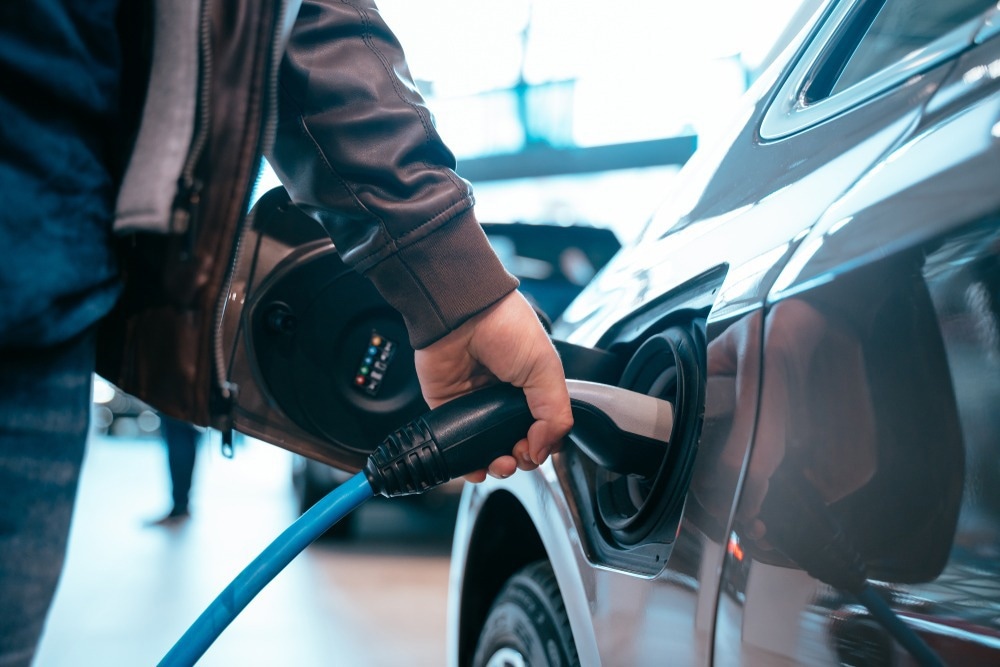Reviewed by Emily Henderson, B.Sc.Nov 8 2022
Scientists at Stanford University have designed a new approach to make lithium-ion battery packs last longer and suffer less from rapid charging.
 Stanford researchers have devised a new way to make lithium-ion battery packs last longer and suffer less deterioration from fast charging. Image Credit: Hrecheniuk Oleksii/Shutterstock.com
Stanford researchers have devised a new way to make lithium-ion battery packs last longer and suffer less deterioration from fast charging. Image Credit: Hrecheniuk Oleksii/Shutterstock.com
The new study has shown how actively controlling the amount of electrical current running to every cell in a pack, instead of giving charge evenly, can reduce wear and tear. The method enables every cell to live its best and longest, life efficiently.
The study was reported in the IEEE Transactions on Control Systems Technology journal on November 5th, 2022.
As per Stanford professor and senior study author Simona Onori, first simulations indicate batteries regulated with the new technology could tackle a minimum of 20% more charge-discharge cycles, even with regular quick charging. This puts additional struggle on the battery.
The majority of the earlier efforts to lengthen electric car battery life have concentrated on enhancing the materials, design, and manufacturing of single cells. This depends on the premise that, like links in a chain, a battery pack seems only as good as its fragile cell.
The new study starts with the knowledge that while weak links are unavoidable, due to manufacturing imperfections and since few cells degrade quicker than others as they are exposed to stresses like heat, they need not bring down the full pack. The key is to customize charging rates to the special capacity of every cell to stave off failure.
If not properly tackled, cell-to-cell heterogeneities can compromise a battery pack's longevity, health, and safety and induce an early battery pack malfunction. Our approach equalizes the energy in each cell in the pack, bringing all cells to the final targeted state of charge in a balanced manner and improving the longevity of the pack.
Simona Onori, Study Senior Author and Assistant Professor, Energy Science Engineering Doerr School of Sustainability, Stanford University
Inspired to Build a Million-Mile Battery
Part of the impetus for the new study goes back to a 2020 announcement by Tesla, the electric car company, of work on a so-called “million-mile battery.” This would be a battery that has the potential to power a car for 1 million miles or more (with normal charging) prior to reaching the point where, like the lithium-ion battery in an old laptop or phone, the EV’s battery carries too little charge to be operative.
Such a battery would surpass automakers’ normal warranty for electric vehicle batteries of 100,000 miles or eight years. Even though battery packs regularly pull through their warranty, consumer confidence in electric vehicles could be reinforced if costly battery pack replacements are still rarer.
A battery that has the potential to still hold a charge after thousands of recharges could also relieve the way for the electrification of long-haul trucks and for the adoption of alleged vehicle-to-grid systems. Here, EV batteries would store and transmit renewable energy to the power grid.
It was later explained that the million-mile battery concept was not really a new chemistry, but just a way to operate the battery by not making it use the full charge range.
Simona Onori, Study Senior Author and Assistant Professor, Energy Science Engineering Doerr School of Sustainability, Stanford University
Associated research has concentrated on single lithium-ion cells, which normally do not lose charge capacity as rapidly as full battery packs.
Interested, Onori and two scientists in her laboratory—postdoctoral scholar Vahid Azimi and PhD student Anirudh Allam—decided to examine how inventive management of the present battery kind could enhance the performance and service life of a full battery pack, which might consist of hundreds or thousands of cells.
A High-Fidelity Battery Model
As an initial step, the scientists created a high-fidelity computer model of battery behavior that precisely portrayed the chemical and physical changes within a battery at the time of its operational life. Few such changes extend in seconds or minutes, while others may take over months or even years.
To the best of our knowledge, no previous study has used the kind of high-fidelity, multi-timescale battery model we created.
Simona Onori, Study Senior Author and Assistant Professor, Energy Science Engineering Doerr School of Sustainability, Stanford University
Onori is also the director of the Stanford Energy Control Lab.
Running simulations along with the model indicated that a modern battery pack could be improved and regulated by embracing variations among its constituent cells. Onori and collaborators imagine their model being utilized to lead the development of battery management systems in the years to come and also that could be deployed in a simple manner in present vehicle designs.
It is not just the electric vehicles that stand to gain. Virtually any application that makes the so-called “stresses the battery pack a lot” could be a promising candidate for improved management informed by the new outcomes stated Onori.
One instance? Drone-like aircraft along with electric vertical takeoff and landing, sometimes known as eVTOL, which few entrepreneurs await to function as air taxis and offer other urban air mobility services over the coming ten years. Even now, other applications for rechargeable lithium-ion batteries beckon, such as general aviation and large-scale storage of renewable energy.
Onori stated, “Lithium-ion batteries have already changed the world in so many ways. It’s important that we get as much as we possibly can out of this transformative technology and its successors to come.”
This study was financially supported by LG Chem (now LG Energy Solution).
Journal Reference:
Azimi, V. et al. (2022) Extending Life of Lithium-Ion Battery Systems by Embracing Heterogeneities via an Optimal Control-Based Active Balancing Strategy. IEEE Xplore. doi.org/10.1109/TCST.2022.3215610.